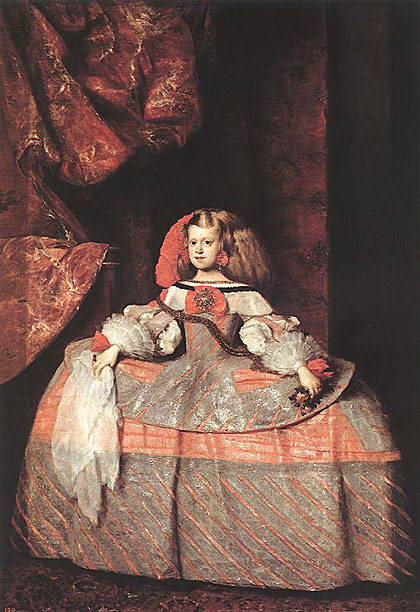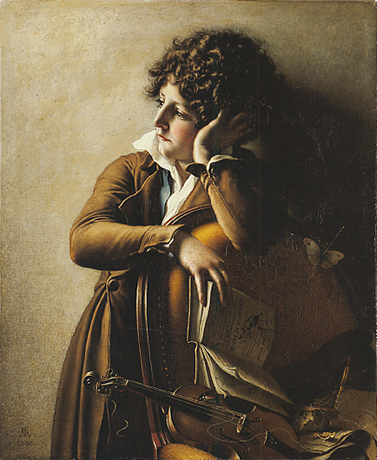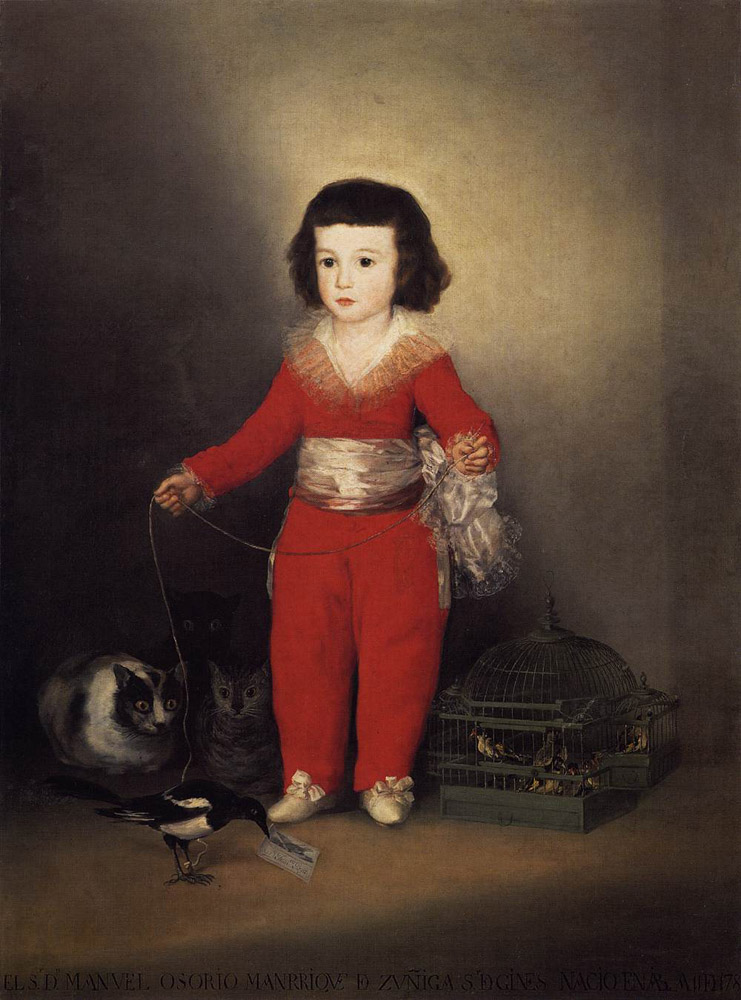To trust, to put faith into the emotional life. To unencumber oneself of the layers of reason and logic, the common sense of classicism that had dominated art to that point. Romantic visions, but with a classical foundation. It added up to the beginning of sensationalism. Before Girodet, no one had consciously attempted to articulate the mental state of a child to this degree, for Girodet very much affirmed that the artist’s vision was more significant than tradition. And with it, he pitched his art to the emotions and hence to the people, dismantling the super-ego purview that royalty had monopolized. …

---Infanta Dona Margarita de Austria--- Velazquez. Read More:http://hoocher.com/Diego_Velazquez/Diego_Velazquez.htm
The child, Benoit Agnes Trioson, was the son of Girodet’s mentor and stepfather. The boy died young, making him all the more “romantic.” (Keats, Shelley and Byron also died young.) Putting his book aside, he gazes off into the distance, thinking his own thoughts, his face radiant with consciousness. He is shown in the traditional pose of melancholy, his head resting on one hand. It is an astonishing psychological portrait, pre-dating Gericault’s portraits of the insane, which attempt to convey their mental state, but are much less convincing than Girodet’s singular portrait….

---Girodet reserves a more profound disclosure of the child's inner state of mind and psychological make-up for the odd, haphazard seeming still-life he has composed on the seat and back of the chair. From the boy's right hand dangles a neglected, open Latin grammar resting on the side of a violin. With closer scrutiny of the still life, the viewer finds that the pages of the grammar book have been covered with defiant doodles, and that the original bridge of the violin has been mischievously replaced by a broken half of a walnut shell . Further details are no less peculiar and telling: a large beetle crawls along the strings of the violin, his leg tethered by a long piece of twine that winds repeatedly around a porte-crayon stuck in a hunk of bread, and then leads finally to a butterfly that has been carefully pinned to the back of the chair. --- Read More:http://www.19thc-artworldwide.org/index.php/spring06/164-girodet-1767-1824
…All the more so because Girodet shows the boy as an individual, not as a type. It is rare enough to treat children as serious persons — Goya and Velazquez do so — and even rarer to realize they have a serious mental life. Girodet was able to convey it, perhaps because he projected his own melancholy into the child, as Bellenger suggests, but also because he had genuine respect and love for his stepbrother. His art has the quality of intimacy that David’s art lacks. Read More:http://www.artnet.com/magazineus/features/kuspit/kuspit8-16-06.aspa

---The portrait of the four-year-old Manuel Osorio is one of Goya's most famous works.The luminous red of his costume makes the pale, serious-looking boy, who was at that time the same age as Goya's own son, look all the more delicate. The background is indistinct. The light falls diagonally, emphasizing the boy's head. Goya added his signature to the card held in the magpie's beak. Three cats are staring through the darkness at the magpie, which the boy is holding on a thin lead. Is this a reference to the passing of childhood innocence, and the captive bird a symbol of the child's restricted freedom? Perhaps; but we have to remember that in those days it was perfectly normal to give children animals as playthings. Goya was able to capture the child's personality with great sensitivity, transcending the purely representational portrayal. His portraits always show a great deal of tenderness for children, who were expected to display fitting dignity and composure from a very early age. The contrast between the child as a child, and the child as an actor in the elaborate and imposing ceremonies that were an inescapable aspect of court life had already been demonstrated by Velazquez in his portraits of the royal children. Goya had studied these works in detail.--- Read More:http://all-art.org/neoclasscism/goya4.html
To capture a child in a portrait, was to grasp a cultural dialogue, complex , and having for a habitat the dynamic impulsive present. Is young Benoit haunted by the specter of time, a dawning on him of ennui, of inertia faced with the passing of empty space, the infinite, near eternal perception of time it appears to become an adult and all the nasty experiences it entails. After all, if even the infantile and the rebel, the perennial adolescents succumb to time, what options are left, for the more aware of time one becomes, the more aware of death…..
With the children’s paintings of Goya we can see the first romantic taste for the peculiar, the slightly macabre, seeing a sense of cruelty as one of the defining aspects of life and the representation of a tragic sense of humanity, perhaps a tragedy borne of their trust in mankind and in painting as an act of redemption from it….







 COMMENTS
COMMENTS



